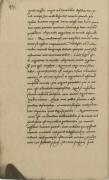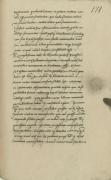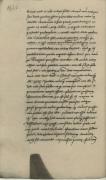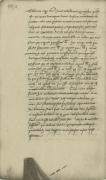Meditata, [Olsztyn] 15 August 1517
Original: lost; Copies: Biblioteka Zakładu Narodowego im. Ossolińskich, Wrocław, rkps 199, pp. 264–269; Archiwum Główne Akt Dawnych, Warszawa, Libri legationum, vol. 5, fol. 170v–173v; Ermlandhaus, Münster, Nachlass von Hans Schmauch (photocopy of Felix Reich's copy lost in 1945).
Copernicus wrote three versions of his treatise on the reform of Prussian coinage in the years 1517–1526 which have survived in the form of copies and translations. As has been proved in the course of a thorough analysis of their contents, they are subsequent versions of the same work. The text of the first draft, usually referred to as Meditata, was written in Latin in 1517. This document was produced with Bishop Fabianus Lusianus and members of the cathedral chapter of Warmia in mind and was to support their arguments in debates on monetary reform held during assemblies of the Estates of Royal Prussia (Stany Prus Królewskich). The treatise consisted of two parts. In the first Copernicus discusses general issues related to the theory of money and formulates inter alia a law of bad money driving out good. In the second he focused on the current monetary situation in Royal Prussia and in particular on the decline in the value of Prussian coinage, enumerating its types and explaining the reasons for the decrease in value of individual coins.
Meditata is the earliest entirely empirical discussion of the monetary question, absolutely devoid of theological arguments and biblical quotations.
Leszek Zygner
Nicolaus Copernicus University
[Olsztyn], 15 August 1517
Coinage is imprinted gold or silver, by which the prices of things bought and sold are reckoned according to the regulations of any State or its ruler. It is therefore a measure of values. A measure, however, must always preserve a fixed and constant standard. Otherwise, public order is necessarily disturbed, with buyers and sellers being cheated in many ways, just as if the yard, bushel, or pound did not maintain an invariable magnitude. Hence this measure is in my opinion the coin's face value. Although this is based on the metal's purity, nevertheless intrinsic value must be distinguished from face value. For, the denomination of a coin may exceed its metallic content, and the other way around.
Coinage was introduced for a necessary reason. Things could have been exchanged for gold and silver by weight alone, because mankind's common judgment prizes gold and silver. But to carry weights around all the time was very inconvenient. The purity of the gold and silver, moreover, was not instantly recognizable. Accordingly people ordained that a coin should be marked with a universally recognized symbol to indicate that it contained the proper proportion of gold or silver, and to add legal authority to confidence [in it].
The face value of a coin is just and proper when the coin contains very little less gold or silver than may be bought with it, since only the expenses of the minters should be deduced. For, the symbol should add some value to the metal.
This [face-value] may be corrupted in three ways. First, the metal, alone may be defective, when for the same weight of coin more than the right amount of copper is alloyed with the silver. Secondly, the weight may be defective, even though the proportion of copper and silver is correct. Thirdly, and this is worse, both defects may be present at the same time.
Money can lose its value also through excessive abundance, if so much silver is coined as to heighten people's desire for silver bullion. For in this way the coinage's market value vanishes when with it I cannot buy as much silver as the money itself contains, and then I find greater advantage in destroying the coin by melting the silver. The solution is to mint no more coinage until it recovers its par value.
The value of a coin deteriorates also by itself as the coin is worn down through long use. Only for this reason should it be renewed or replaced. This is indicated if somewhat less silver is found in the coin than is bought with it.
Hence, whenever a new coinage should be minted, the use of the old coinage must be completely prohibited. People bringing it to the mint must receive new coinage wherein the amount of silver matches precisely what is in the old coinage. But if this is not done, the old coinage will taint the value of the new coinage, for two reasons. For, the mixture [of the old coinage with the new coinage] will reduce the aggregate below the proper weight, and perhaps make it excessively abundant, with the consequences mentioned above. However, the worst mistake, which is absolutely unbearable, is [committed] if the ruler, or whoever governs the State, seeks a profit from the minting of the coinage, to wit, by adding to the money in existence a new coinage which, although defective in metallic content or weight, pretends to have the value of the old coinage. For the ruler cheats not only his subjects but also himself by enjoying a merely temporary and quite modest profit, like a stingy farmer sowing bad seeds to save good seeds: he will reap exactly what he sowed. This evil damages the coinage's worth, just as blight [ruins] grain. After this disease has taken hold and been discovered too late, the ruler will not easily get rid of it without burdening his subjects again and with his reputation unstained, since he himself caused the harm.
I shall now give as an example the Prussian coinage, which has heretofore been subject to many defects. It circulates under the names mark, skoter, and the like, which are also names of weights. As a weight, a mark is 1/2 pound, and 3 skoters make 1 ounce. As a coin, however, a mark consists of 60 shillings. But lest ambiguity give rise to misunderstanding, in what I shall say hereafter, wherever "mark" is used, I want the coin to be understood. On the other hand, where weight is involved, I shall speak of a pound, for instance, 2 marks make a pound.
Now the money which we use at the present time consists of shillings, groats, and pence. I find, however, that the coins now called "groats" were once shillings, and that 8 marks contained 1 pound of pure silver, as is learned also from their content. For they consist half of copper and half of silver, and 8 of these marks, at 60 shillings to the mark, weigh almost 2 pounds. These were called "new shillings" and the corresponding marks "new marks" or "good marks".
For there were also the other "old shillings" ant the corresponding "old mark" or "light mark." These were equal to the new coins in weight, but had 1/2 their value. For only 1/4 of their content was silver, and 16 marks contained 1 pound of silver, while weighing 4 times as much.
Later, when the country's status changed, cities were granted the right to mint coins. As they exercised their new privilege, currency increased in quantity, though not in quality. Four parts of copper began to be alloyed with a fifth part of silver, until 1 pound of fine silver cost 20 marks. Since part of the old coinage still circulated, however, those new shillings became skoters, reckoned at 24 to 1 light mark. For 1 [60-]shilling mark was at that time not much better than those 24 [skoters].
Afterwards, however, those new shillings, having become skoters, disappeared because they were accepted also throughout the Mark [of Brandenburg] and Pomerania. It was decided to recover them by evaluating them at 1 groat, that is, 3 shillings. This was a very bad miscalculation, quite unworthy of so distinguished a body of notables [as the Estates of West Prussia. It was] as though they rejoiced at their own misfortunes, because forsooth Prussia could not get along without those [groats], even though they were worth no more than 15 pence and without them there was more than enough currency.
The groat therefore differed from 3 shillings, being worth 1/5 or 1/6 less. Yet because it was mistakenly evaluated as their equal, it dragged down the value of the shillings while attaching their good quality to itself. It brought about a confusion of the mixed coinage's market value and intrinsic value. Consequently the money's market value fell lower and lower day after day. Nevertheless it was decided not to interrupt the coining of money at all. The costs did not cover the minting of coins equal in value to the previous coinage. What was minted, therefore, always fell somewhat short of the steadily declining market value. The later coinage, always inferior to the earlier coinage, as it was introduced depressed the market value of the previous coinage, and drove it out. [This continued] until the shilling's market value equaled the groat's intrinsic value, and 1 pound of silver cost 24 light mark. This has not stopped yet, up to the present time. Indeed, even after the approximate equalization [of the shilling's market value] with the groat, this is now followed by ever new groats, which are deficient at least in weight. For, 26 marks weighing 2 pounds contain 1 pound of silver. What is to be expected except that soon 1 pound of silver will cost 26 marks, unless help is forthcoming in the meantime?
Such grave evils, then, beset Prussian money and because of it, the whole country. Its calamities benefit only the goldsmiths, who know the purity of metal by experience. For from the mixed coinage they collect the old pieces, from which they melt down the silver and sell it. From the inexperienced public they constantly receive more silver with the coinage. After these old shillings disappeared completely, those following next [in intrinsic value] are selected, like wheat being winnowed from chaff. Would that these [distortions] were reformed, while there is time, before a greater disaster! At least let 1 pound of silver be brought back again to 20 marks, and held there for the future by the method described above.
I shall accordingly add an example of this reform. First, only one place should be designated for the minting of money, not for a single city or under its emblem, but for the entire country. In the absence of a decision by the country's nobility and cities, no new money should be minted henceforth. There should be no exception, moreover, to the rule that not more than 20 marks should be struck from 1 pound of fine silver.
The procedure should be as follows. For the shillings, take 3 pounds of copper and 1 pound of fine silver, minus 1/2 ounce or only as much as must be deduced for expenses. From the molten mass strike 20 marks, which in purchasing power will be worth 1 pound of silver. Furthermore, mint the skoters from 2 pounds of copper and 11 3/4 ounces of silver, making 20 marks, with 24 [skoters to the mark]. But perhaps it would be better if instead of shillings, half-shillings were minted in accordance with the above reckoning. Five half-shillings would be exchanged for 1 skoter, and 1 half-shilling for 4, of the present pennies.
When this minting has begun, however, the use of the old coinage should be prohibited. In the mint, for 13 old marks, 10 new ones should be exchanged, either in shillings or groats. For, this less will have to be suffered once, in order that it may be followed by many benefits and a lasting advantage, and that a single currency reform in 25 or more years may be enough.
Let these remarks about money suffice. I leave them to be analyzed by anybody who has better understanding, as new situations constantly present themselves in the course of time.
N. C. Meditata. 15 August 1517
Translation by Edward Rosen
[Olsztyn], 15 August 1517
Moneta est aurum vel argentum signatum, qua precia emptibilium vendibiliumque rerum numerantur secundum cuiusuis rei publice constitutum vel gubernantis ipsam. Est igitur mensura quedam estimacionum; oportet autem mensuram firmum semper ac statum servare modum. Alioqui necesse est confundi ordinacionem rei pu[blice], ementes quoque et vendentes multipliciter defraudari, quemadmodum si vlna, modius pondusue certam quantitatem non seruet. Hanc ergo mensuram estimacionem puto ipsius monete, que et si in bonitate materie fundetur, oportet tamen valorem ab estimacione discernere; potest enim pluris estimari moneta, quam eius, qua constat, materia et [e]conuerso. Causa vero constitucionis monete necessaria est. Quamuis enim auri et argenti solo pondere rerum commutatio fieri posset, ex quo communi hominum consensu aurum et argentum in precio habeatur. Sed propter multam incommoditatem afferendorum semper ponderum, quodque non statim auri et argenti sinceritas deprehenderetur, ab hominibus institutum est publico sigillo monetam signari, que significetur iustam auri vel argenti partem inesse et fidei autoritas adhibeatur. Iusta autem et equa monete estimacio est, quando paululo minus auri vel argenti continet, quam pro ipsa ematur, utpote quantum pro expensis dumtaxat monetariorum oportuerit deduci; debet enim signum aliquam materie addere dignitatem. Potest hec tribus modis deprauari, vel propter defectum materie solum, quando sub eodem pondere monete plus, quam oportet, es commiscetur argento; vel propter defectum ponderis, quamuis iustam habeat eris et argenti mixtionem; vel, quod peius, propter vtrumque simul. Potest eciam propter immoderatam multitudinem moneta vilescere, si tantum argenti in monetam redigitur, donec argenti massa magis ab hominibus desideretur. Perit nempe hoc modo dignitas monete, quando per ipsam tantum argenti emere mihi non licet, quantum ipsa pecunia continet senciamque tunc maiorem profectum eliquando argentum in monete destructionem. Remedium est et non amplius monetam cudere, donec se ipsam coequauerit. Vilescit eciam vltro valor monete longo vsu detrite, propter quod solum instaurari aut innouari debet.
Cuius signum est, si argentum in moneta aliquanto minus reperitur, quam pro ipsa emptum. Quocies ergo noua fieri debet, opere precium est antique vsum interdicere omnino et ut eam inferentes in argentaria officina recipiant nouam, qua argenti quantitas, que in antiqua est, admodum compe[n]setur. Quod si neglectum fuerit, inficiet antiqua noue monete dignitatem duplici racione. Mixta enim reddet summam a iusto pondere deficientem et nimium forsan multiplicatam; sequetur, quod dixi superius. Maximus vero error est et admodum intollerabilis, si dominus, vel apud quem est rei publice gubernatio, ex monete cussione lucrum querat, dum videlicet preexistenti monete, materia vel pondere deficientem nouam inducit sub pretextu estimacionis antique. Fallit enim non subditos solum, sed eciam se ipsum presenti tantummodo gaudentem lucro et quidem modico, non aliter quam parcus seminator, qui mala semina mittit, vt seruet bona; metet itidem, que seminauit. Infestat malum hoc estimacionem monete, perinde ac rubigo frumenta, quod postquam inualuerit fueritque iam sero deprehensum, non facile commouebit dominus sine subditorum altero grauamine neque honeste satis, utpote cuius causam prestiterit ipse. Exemplificabo nunc de moneta Prussie multis vicijs hactenus obnoxia. Transit autem sub nominibus marcarum et scotorum etc. et sunt sub eisdem nominibus eciam pondera: marca ponderis est libra j et scoti III faciunt vnciam I; marca autem numeri constat solidis LX. Verum, ne equiuocacio obscuritate(m) pariat, in ijs, que in sequentibus dicam, vbicumque marca dicetur, numerum intelligi volo; pro pondere vero libram nominabo, quemadmodum marce II constituunt ipsam. Pecunia igitur, qua modo vtimur, ex solidis, grossis et denarijs constat. Inuenio autem ea numismata, que nunc grossi vocantur, aliquando solidos fuisse et marcas VIII libram I habuisse purissimi argenti, quod eciam ex ipsorum composicione deprehenditur. Constant enim ex dimidio eris et argenti et eorum marce octo per LX pendunt prope libras duas et hos vocabant nouos solidos et eorum nouas marcas siue bonas. Erant enim et alii antiqui solidi et eorum marca antiqua siue leuis, pondere quidam pares illis, valore autem ex dimidio; erat enim in ijs quarta pars dumtaxat argenti et marce XVI libram vnam argenti continebant pendentes quadruplum. Deinde mutato statu patrie, cum ciuitatibus esset cudendi monetam concessa potestas et ipse nouum exequerentur priuilegium, creuit pecunia multitudine, non autem bonitate cepitque IIII partibus eris quinta argenti misceri, donec pro marcis viginti libra argenti purissimi emeretur. Manente autem adhuc antiqua partim moneta noui illi solidi facti sunt scoti, vt XXIIII pro marca leui computarentur; erat enim tunc marca I solidorum non multo melior quam illi XXIIII. Postea vero, quam euanescerent noui illi solidi iam scoti facti eo, quod eciam per Marchiam et Pomeraniam accepti essent, placuit eos grossorum estimacione reuocare, hoc est sub solidis tribus, maximo errore et tanto procerum consilio prorsus indigno, quasi proprijs malis gaudencium, quod scilicet Prussia non posset esse sine illis, quamuis non essent meliores denarijs XV et absque is erat moneta plus quam aufficiens. Dissidebant ergo grossi cum solidis tribus quinta vel sexta parte minus valentes; estimacione tamen fallaci pares detrahebant dignitati solidorum, bonitatem eorum sibi mencientes et promiscui pecunie estimacionem cum bonitate confundentes. De[cre]scebat ergo in dies magis ac magis estimacio pecunie. Placuit tamen a fabricacione monete plane non cessare et cum expense non sufficerent, vt equivalens priori cuderetur, facta est semper, que estimacioni continue labanti vix satisfaceret. Itaque posterior et peior semper priori inducta estimacionem precedentis oppressit et extrusit, donec estimacio solidorum et grossorum valor coequaretur et marce XXIIII leues pro libra cedant argenti necdum cessatur vsque in presens, quin eciam post equatam iam fere estimacionem cum grossis noui iam eciam grossi succedunt pondere saltem deficientes; nam marce XXVI libras duas pendentes libram I argenti habent. Quid restat, nisi ut proxime marcis XXVI libra argenti ematur, nisi interim succursum fuerit. Tantis ergo vicijs laborat Prussiana moneta et per eam tota patria. Soli aurifices eius erumnis fruuntur bonitatem metalli callentes; colligunt enim ex promiscua pecunia antiquam, ex qua eliquatum argentum vendunt, plus semper argenti cum moneta recipientes ab imperito vulgo. Et postquam antiqui illi solidi iam penitus euanuerunt, eliguntur proxime sequentes tanquam ex auenis triticum. Vtinam reformentur hoc, dum tempus est, ante ruinam maiorem, ut saltem ad XX marcas libra argenti restitueretur et retineretur in futurum per artem supra dictam. Subiciam ergo hoc eciam huius reduccionis exemplar. Primum est, ut vnus duntaxat locus cusioni monetarije deputetur, vbi non ciuitatis vnius vel sub eius insignis, sed tocius patrie et quatenus sine optimatum terre ac ciuitatum decreto non fiat deinceps noua moneta, decreto autem inuiolabili, ne vltra XX marce fiant ex argenti purissimi libra. Hoc nempe modo pro solidis sumantur eris libre III, argenti puri libra I minus vncia dimidia, vel quantum necesse fuerit pro expensis duntaxat detrahendum; confletur massa, ex qua marce XX fiant, que in empcione valebunt argenti libram vnam. Fiant eciam scoti ex eris libris duabus et vnceis XI quartis tribus argenti pro marcis XX per XXIIII. Sed magis forsan conueniret, si pro solidis semisolidi formarentur ad predictam racionem, vt essent quinque pro scoto et semisolidi pro IIII denarijs remanentibus commutarentur. Cum autem incepta fuerit hec monetacio, interdicatur vsus antique et in monetaria pro marcis tredecim antique reddantur decem noue siue solidorum, siue grossorum. Oportebit enim hoc dampnum semel pati, vt multa inde bona sequantur et constans vtilitas et in vigintiquinque vel pluribus annis semel renouasse monetam satis sit. Et hec de moneta sufficiant, que meliori iudicio examinanda relinquo, quemadmodum cum tempore noui semper casus sese offerunt.
N. C. Meditata XV Augusti anno Domini MDXVII
 English (United Kingdom)
English (United Kingdom)  Polski (PL)
Polski (PL) 











